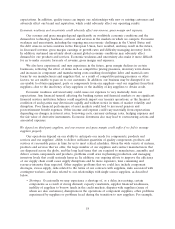HP 2011 Annual Report Download - page 36
Download and view the complete annual report
Please find page 36 of the 2011 HP annual report below. You can navigate through the pages in the report by either clicking on the pages listed below, or by using the keyword search tool below to find specific information within the annual report.Unanticipated changes in HP’s tax provisions, the adoption of new tax legislation or exposure to additional
tax liabilities could affect our profitability.
We are subject to income and other taxes in the United States and numerous foreign jurisdictions.
Our tax liabilities are affected by the amounts we charge for inventory, services, licenses, funding and
other items in intercompany transactions. We are subject to ongoing tax audits in various jurisdictions.
Tax authorities may disagree with our intercompany charges, cross-jurisdictional transfer pricing or
other matters and assess additional taxes. We regularly assess the likely outcomes of these audits in
order to determine the appropriateness of our tax provision. However, there can be no assurance that
we will accurately predict the outcomes of these audits, and the amounts ultimately paid upon
resolution of audits could be materially different from the amounts previously included in our income
tax expense and therefore could have a material impact on our tax provision, net income and cash
flows. In addition, our effective tax rate in the future could be adversely affected by changes to our
operating structure, changes in the mix of earnings in countries with differing statutory tax rates,
changes in the valuation of deferred tax assets and liabilities, changes in tax laws and the discovery of
new information in the course of our tax return preparation process. In particular, the carrying value of
deferred tax assets, which are predominantly in the United States, is dependent on our ability to
generate future taxable income in the United States. In addition, President Obama’s administration has
announced proposals for other U.S. tax legislation that, if adopted, could adversely affect our tax rate.
There are also other tax proposals that have been introduced, that are being considered, or that have
been enacted by the United States Congress or the legislative bodies in foreign jurisdictions that could
affect our tax rate, the carrying value of deferred tax assets, or our other tax liabilities. Any of these
changes could affect our profitability.
Our sales cycle makes planning and inventory management difficult and future financial results less
predictable.
In some of our segments, our quarterly sales often have reflected a pattern in which a
disproportionate percentage of each quarter’s total sales occurs towards the end of such quarter. This
uneven sales pattern makes prediction of revenue, earnings, cash flow from operations and working
capital for each financial period difficult, increases the risk of unanticipated variations in quarterly
results and financial condition and places pressure on our inventory management and logistics systems.
If predicted demand is substantially greater than orders, there will be excess inventory. Alternatively, if
orders substantially exceed predicted demand, we may not be able to fulfill all of the orders received in
the last few weeks of each quarter. Other developments late in a quarter, such as a systems failure,
component pricing movements, component shortages or global logistics disruptions, could adversely
impact inventory levels and results of operations in a manner that is disproportionate to the number of
days in the quarter affected.
We experience some seasonal trends in the sale of our products that also may produce variations
in quarterly results and financial condition. For example, sales to governments (particularly sales to the
U.S. government) are often stronger in the third calendar quarter, consumer sales are often stronger in
the fourth calendar quarter, and many customers whose fiscal and calendar years are the same spend
their remaining capital budget authorizations in the fourth calendar quarter prior to new budget
constraints in the first calendar quarter of the following year. European sales are often weaker during
the summer months. Demand during the spring and early summer also may be adversely impacted by
market anticipation of seasonal trends. Moreover, to the extent that we introduce new products in
anticipation of seasonal demand trends, our discounting of existing products may adversely affect our
gross margin prior to or shortly after such product launches. Typically, our third fiscal quarter is our
weakest and our fourth fiscal quarter is our strongest. Many of the factors that create and affect
seasonal trends are beyond our control.
28
























